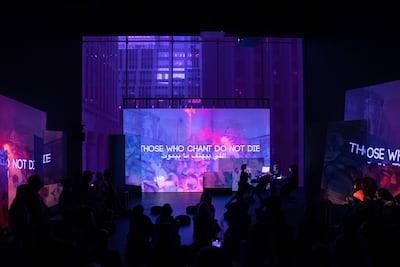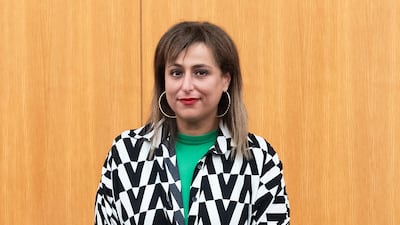Sheikha Hoor Al Qasimi has long refused to separate art from politics. At this year’s Aichi Triennale in Japan – her first major international project since the Israel-Gaza conflict began nearly two years ago – she brings Palestine to the centre of the conversation, framing the festival through a lens of resistance and solidarity.
Sheikha Hoor is an Emirati curator and president of Sharjah Art Foundation, which she founded in 2009. She also directs Sharjah Biennial, leads Sharjah Architecture Triennial and is president of the International Biennial Association. Now, she has become the first non-Japanese artistic director of Aichi Triennale, Japan’s largest international art festival.
The festival’s theme, A Time Between Ashes and Roses, was chosen in early 2023, months before the current crisis – yet its resonance has only grown. Drawn from a 1970 poem by Adonis, the title is one Sheikha Hoor has long associated with Palestine.
Speaking to The National in Nagoya, she says: “It was very much important for me in terms of a title. I contacted Adonis and he said: ‘Yes, you can use it, of course.’ Poetry does something that connects to people, and it can be approachable as well.
president, Sharjah Art Foundation
It’s simple in its title, but deep in its meaning. People are always asking me: 'What is the between? What are you talking about?' And I think we are living between two extremes for sure. At a time when there are more ashes, the roses probably hit harder.”
Sheikha Hoor says the current context has transformed how the title is read. “I didn’t really expect it to be so important to have it as it is, just because Palestine has always been central for me,” she says. “It’s been emotional to think about how connected it is. I think that the title, now more than ever, is looking back at 1967. I hope people take a lot out of that.”
At the triennale’s opening press conference, with media from across Japan present, Sheikha Hoor spoke even more directly. She invoked the Naksa following the Arab-Israeli War of 1967 and what she described as the “genocide and ethnic cleansing” taking place today.

“It’s been a very emotional experience,” she told the audience. “I echo many people when they say, none of us will be free until all of us are free. So, free Palestine.” She also linked this to wider indigenous struggles, citing artists from Guatemala and Australia whose work speaks to colonialism, dispossession and resilience.
Palestine is a part of the festival in more than just what’s displayed – its presence is also marked by the absence of artists who could not make it. “I was not sure we will get visas for a lot of the Palestinian musicians,” says Sheikha Hoor. “Mirna Bamieh couldn’t come because of her being in Portugal and waiting for papers. And the same with Haykal not being able to leave the US in case he can’t go back in. It also kind of brings to the forefront all these issues – reasons why artists couldn’t travel.”
Still, she managed to secure visas for Basel Abbas, Ruanne Abou-Rahme and Baraari, who performed on Friday on Nagoya’s club scene. “I knew I wanted to show their installation for sure, but I also know that Nagoya has a night scene and a lot of young people always dancing on the street. Music is really important. I did a lot of club scouting. One club was very supportive. They wanted to collaborate and to bring in Japanese musicians with Basel, Ruanne and Haykal. I think they will collaborate in the future.”

While Aichi Triennale was very supportive of Sheikha Hoor's vision, she still notes that, overall, accepting her politics is a prerequisite for any collaboration she takes on. “I’m not the type who would change my political views for anyone,” she says. “I’ve said before: these are my views, this is what I support, this is who I am. If somebody doesn’t want me here, I don’t need to be here. But I’ve had support, so that’s been good.”
She views her role as using whatever platform she has to say what others cannot. “It’s something everybody wants to say, but not everybody has the mic. So if you do, just say it.”
Even as Palestine defines the triennale’s framework, Sheikha Hoor also places Emirati artists prominently within it. For Mohammed Kazem, she revisits works tracing Dubai’s transformation and his Directions series.
“I wanted to bring some of his older works looking at the development of Dubai and navigation and belonging in space. And with Directions, a lot of people have seen the UAE Pavilion version in the 2013 Venice Biennale, which was very high-tech. I wanted to show the previous one, which was more low-tech, just to understand how he came to that project and what was behind it.”
Elsewhere, Afra Al Dhaheri's installations include her own hair. “Her older work with hair and the fragility of something like curly hair, I thought would really connect with the Japanese audience's way of looking at materials,” says Sheikha Hoor.
Shaikha Al Mazrou transforms an unused outdoor fountain at Seto City Museum into a sculptural pool. “She already had this idea of doing a pool, and we were outside the museum and I said this pool has been empty every time I come. They said: 'Yes, there’s no water in it'. So they allowed us to do that installation. I was really happy about that, and I think it’s one of her best works.”
Emirati mixed-media artist Maitha Abdalla, as well, presents a new series of paintings about motherhood and renewal.
In Japan, Sheikha Hoor carries over the ethos she sharpened in Sharjah – weaving a global tapestry of voices to present a unified and diverse statement. “It’s different each place but, for me, it’s always about teamwork. I don’t like to impose anything. It’s collaborative.
“That’s why I worked with the curator team here for them to suggest artists. We did studio visits together. As much as I come and visit places, I’m not from here. I want to hear about local experiences and spaces to make it more connected to people. You can’t do that as a person flying in and out. You have to work with the local team.”
That ethos extended from artists to civic officials. “For Japanese audiences, it’s been very eye-opening. Even city officials said this is the first time they’ve seen an international show looking not only at the West, but also at the Global South,” she says. “They were very interested, but also curious. They said: 'Is it because of the theme or the title?' And I said: 'No, that’s just the world that I live in and the artists that I work with.'”
Though Aichi has just opened, Sheikha Hoor is already looking ahead – particularly to her next major international role as artistic director of the Biennale of Sydney 2026. She describes it as an honour and privilege, and says she aims to bring the same ethos she has championed in Japan: working closely with local artists and communities, amplifying voices that have been sidelined, especially indigenous and diasporic ones, and exploring what she calls the “multifaceted cultures and perspectives” that form the city.
For her, this isn’t a departure but a continuation – carrying Palestine’s presence forward, opening the floor to under-represented voices from the region and beyond, and expanding the Global South’s place overall in the international art conversation.
As she said in the opening press conference: “What we’re seeing today is connected. This exhibition is a reminder that we all live under the same sky, and we’re all connected in all of our issues. There is always colonialism and occupation at the root of a lot of this evil.”
Aichi Triennale, at venues across Nagoya, Aichi and Seto in Japan, runs until November 30


